初中英语语法系列---简单并列句课件(共37张PPT)
文档属性
| 名称 | 初中英语语法系列---简单并列句课件(共37张PPT) |  | |
| 格式 | ppt | ||
| 文件大小 | 8.1MB | ||
| 资源类型 | 试卷 | ||
| 版本资源 | 通用版 | ||
| 科目 | 英语 | ||
| 更新时间 | 2020-10-20 18:13:50 | ||
图片预览

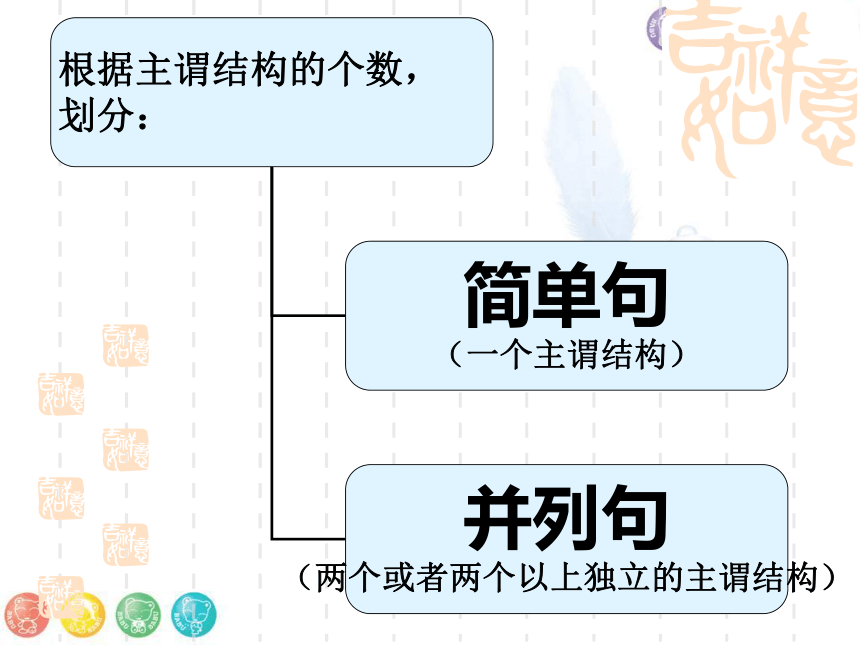
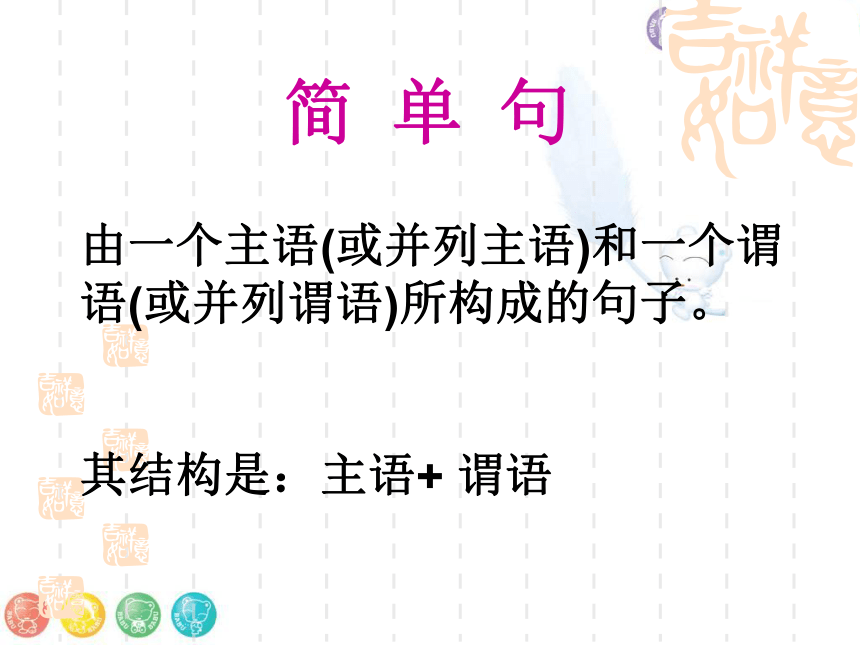
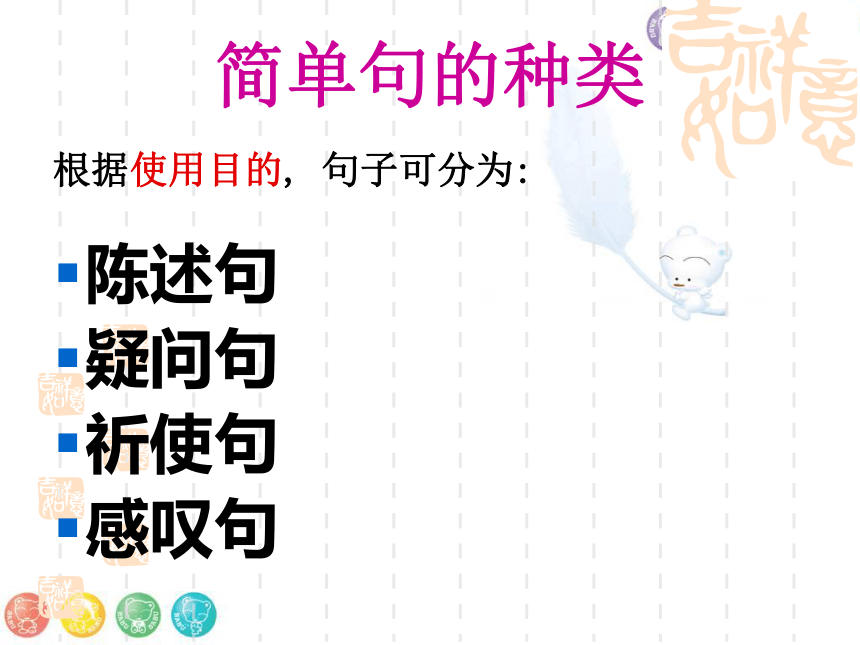

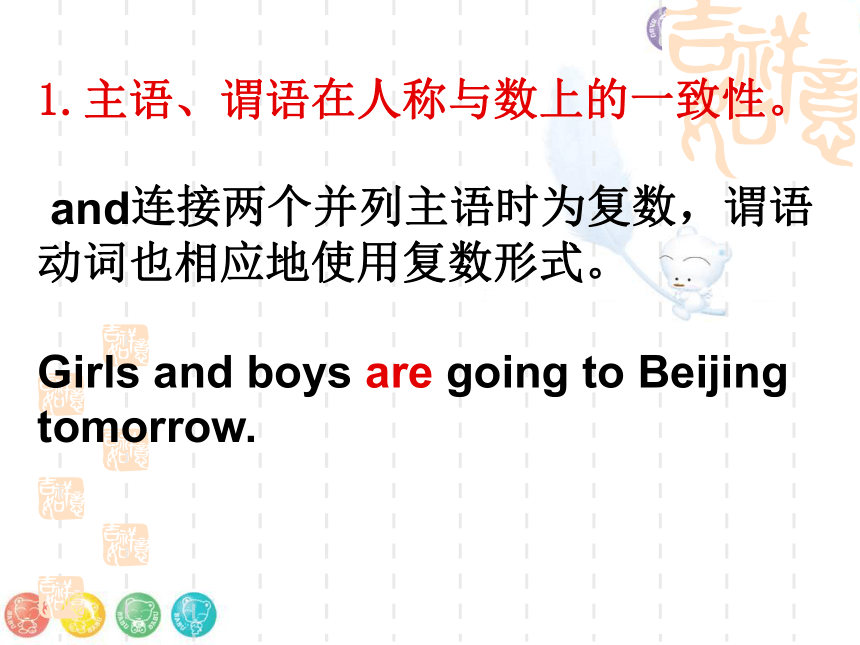


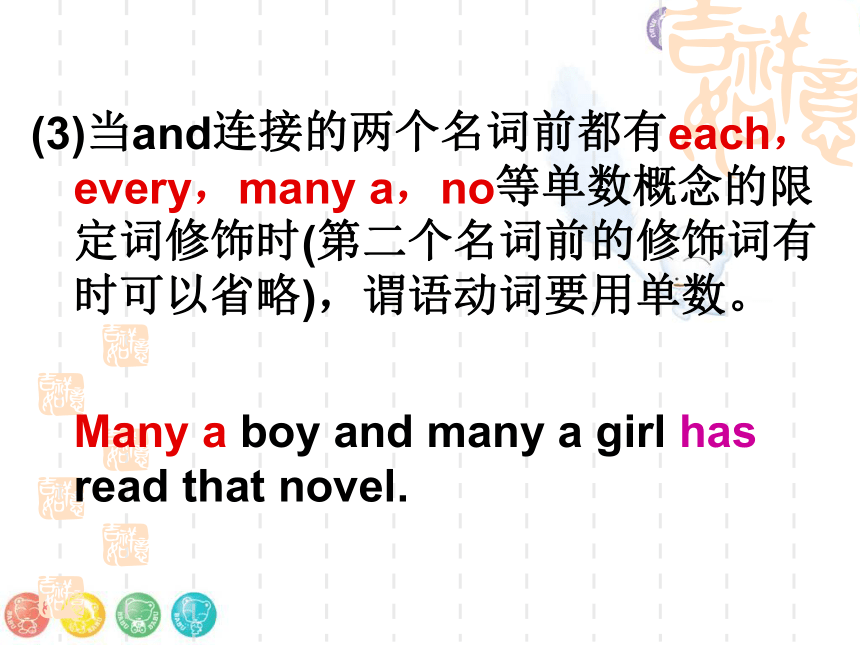
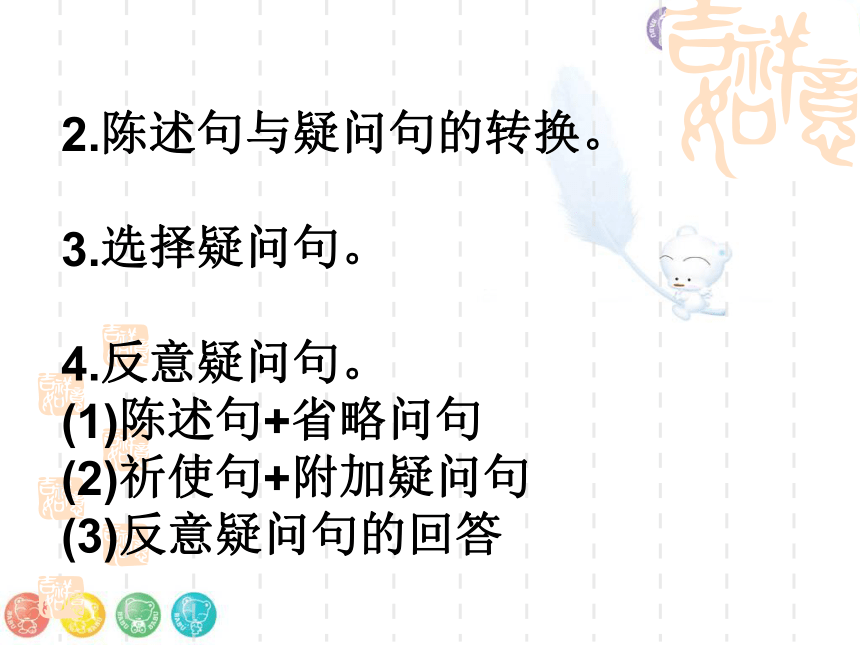
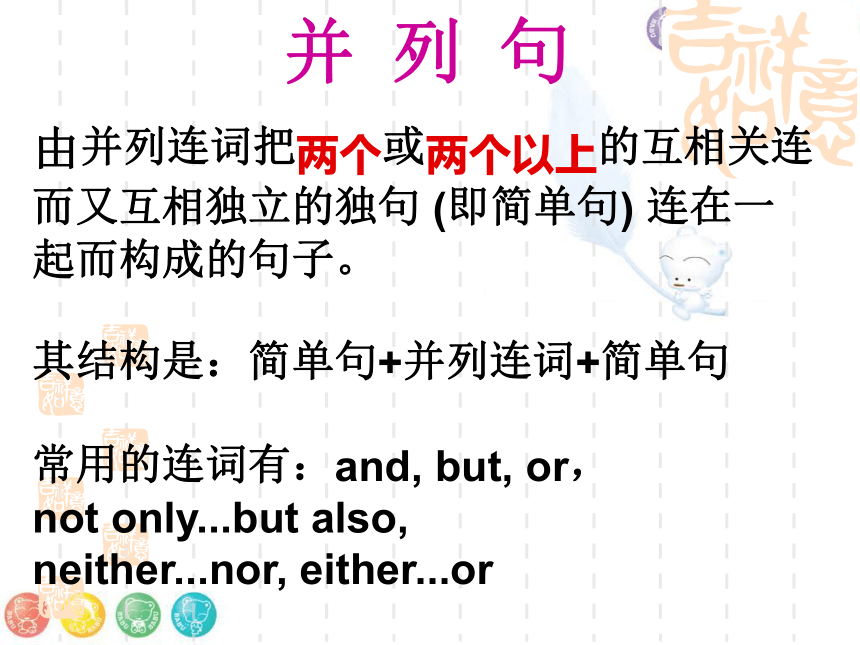
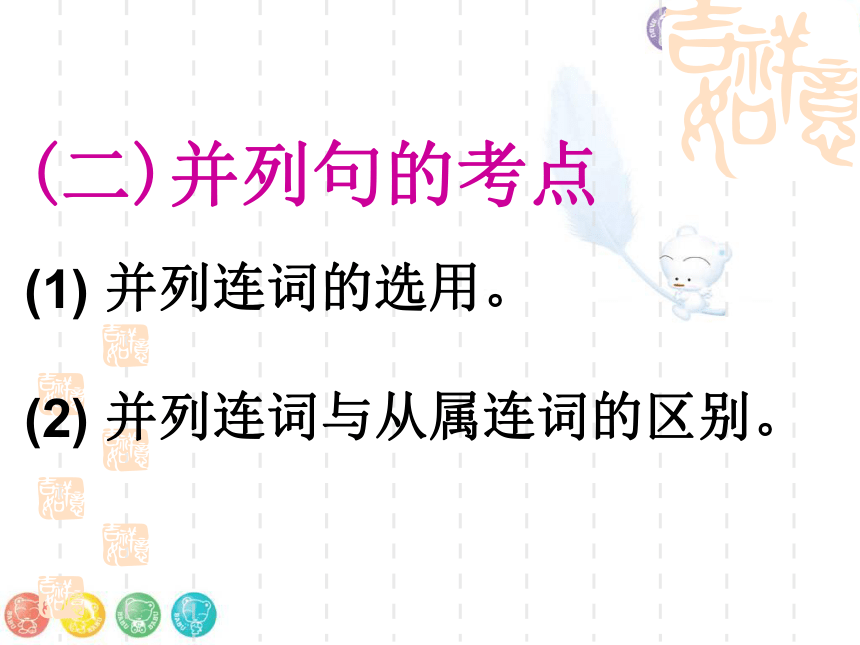
文档简介
句型第三讲:
简单句
并列句
根据主谓结构的个数,
划分:
简单句
(一个主谓结构)
并列句
(两个或者两个以上独立的主谓结构)
简 单 句
由一个主语(或并列主语)和一个谓语(或并列谓语)所构成的句子。
其结构是:主语+ 谓语
简单句的种类
根据使用目的, 句子可分为:
陈述句
疑问句
祈使句
感叹句
简单句的六种基本结构
主语+不及物动词
主语+系动词+表语
主语+及物动词+宾语
主语+及物动词+间接宾语+直接宾语
主语+及物动词+宾语+宾语补足语
(参见 P82 简单句的五种基本句型)
There be +主语句型
1.主语、谓语在人称与数上的一致性。
and连接两个并列主语时为复数,谓语
动词也相应地使用复数形式。
Girls and boys are going to Beijing
tomorrow.
但以下几种情况例外:
(1). 如果and连接的两个名词是不可数
名词且前面都没有冠词。
若两个词表示一个事物或一个概念,
谓语动词要用单数;
Tea and milk is my favorite drink.
奶茶是我最爱的饮料。
This?bread?and?butter is too?thick.
这块涂了黄油的面包太厚了。
fish and chips 鱼炸薯条
如果两个词表示的是两个事物或两个概念,
谓语动词则要用复数。
(2)如果and连接的是两个可数单数名词,前一个有冠词,后一个没有冠词,意味着一个人或事物,谓语动词要用单数。
The singer and dancer is a good student.
这位歌舞演员是位好学生。
(3)当and连接的两个名词前都有each,every,many a,no等单数概念的限定词修饰时(第二个名词前的修饰词有时可以省略),谓语动词要用单数。
Many a boy and many a girl has read that novel.
2.陈述句与疑问句的转换。
3.选择疑问句。
4.反意疑问句。
(1)陈述句+省略问句
(2)祈使句+附加疑问句
(3)反意疑问句的回答
并 列 句
由并列连词把两个或两个以上的互相关连而又互相独立的独句 (即简单句) 连在一起而构成的句子。
其结构是:简单句+并列连词+简单句
常用的连词有:and, but, or,
not only...but also,
neither...nor, either...or
(二)并列句的考点
(1) 并列连词的选用。
(2) 并列连词与从属连词的区别。
并列连词: 连接两个或两个以上地位平等的词,词组,分句或句子的连词。
从属连词: 连接两个或两个以上的分句(从属关系),用来引导复杂句中的从属分句(名词性从句、定语从句和状语从句)的连词。
并 列 连 词
并列连词连接地位平等的词,短语或者句子。常见的并列连词有:
(1)表并列关系的: and, both…and, not only…but also, neither…nor等。
(2)表选择关系的: or, either…or等。
(3)表转折关系的:but, while等。
(4)表因果关系的: for, so等。
就近一致原则
在并列连词 either A or B(或者A或者B) , A or B (A或者B) ,neither A nor B (既不是A也不是B), not only A but also B (不仅A而且B) ,not A but B (不是A而是B) , 引导两个并列主语A和B:
For example(例如):
Neither I nor he has finished the homework.
谓语动词与靠近的名词、代词(B)在“人称、数”上一致。另外there be+句型,谓语动词be也遵循就近一致原则。
一、
并列连词
1. Mary likes music ___Tom is found of sports.
A. and B. but C. both A and B
2. I failed again, ___ I won’t give up.
A. and B. but C. so
3. This is my first lesson, __ I don’t know your names.
A. and B. but C. so
and : 表对等 “和、并且”
but: 表转折 “但是”
so: 表因果 “所以”
and, or, but, so 基本用法
4. Which do you like better, apples, __ pears?
A. and B. but C. or
5. Now we have no time _____ money. ?
A. so B. and C. or?
or: 1. 用于疑问句, 表选择:“或”
2. 用于否定句, 表并列:“和”
一、
并列连词
6. Try your best __ you’ll make more progress.
A. and B. but C. or
7. Don’t lose heart, __ you’ll lose all.
A. and B. so C. or
and 和 or 都可以在祈使句中使用,区别如下:
and: 通常是比较好的结果;
or: 则表示不愉快或不理想的结果.
and, or, but, so 基本用法
一、
并列连词
8. It’s getting warmer __ warmer.
A. and B. but C. or
9. He or the twins __ the USA.
A. comes from B. come from
C. is from
10. Not Tom but I ___ going to give the talk.
A. am B. is C. are
adj.比 + and + adj.比 表示越来越…
A or B 和 not A but B 结构作主语时,谓语动词要使用就近原则。
and, or, but, so 特殊用法
一、
并列连词
12. Both Peter and I ___ going to Guangzhou.
A. are B. is C. am
13. Either apples or rice __ Ok. I am hungry.
A. are B. is C. /
14. Neither I nor my parents ___ to tell you the truth.
A. wants B. want C. is going to
15. Not only I but also Jane __ sure that we’ll win.
A. is B. are C. am
both…and…
either…or…
neither…nor…
not only…but also…
以上结构做主语,除both…and… 谓语要用复数外,其余都遵循谓语动词的就近一致原则。
从属连词
从属连词用来引导从句。常见的从属连词有:
(1)引导时间状语从句的:after, before, when, while, as, until, till, since, as soon as等。
(2)引导条件状语从句的: if(如果), unless, as long as 等。
(3)引导原因状语从句的: because, as, since等。
(4)引导目的状语从句的: so that, in order that等。
(5)引导让步状语从句的: though, although, even if等。
(6)引导结果状语从句的: so that, so…that, such…that等。
(7)引导比较状语从句的: than, as…as等。
(8)引导宾语从句的: that, if (是否), whether等。
主将从现原则
(在时间状语从句&条件状语从句中,如主句是一般将来时,从句用一般现在时代替一般将来时。)
(1)引导时间状语从句的:after, before, when, while, as, until, till, since, as soon as(一…就…)等。
(2)引导条件状语从句的: if (如果), unless (除非), as long as(只要) 等。
不可同现原则
Although(虽然) 和 but(但是) 不能同时出现同一简单句中。
Because (因为)和 so(所以) 不能同时出现同一简单句中。
可以用although/ though….yet 句型
宾语从句的时态与语序
1. 当主句的谓语动词是一般现在时时,其宾语从句的时态可以是任何适当的时态。(应根据实际情况而定)。
主句的谓语动词的时态是一般过去时的时候,其宾语从句的时态一般要用任一适当的过去时态(一般过去时,过去进行时,过去完成时,过去将来时…)。
宾语从句的语序必须是陈述语序。(主语+谓语)
If 引导宾语从句时,时态也要看这两点
1. I’ll tell your father the truth as soon as he ___ here.
A. arrives B. arrived C. arrives at
2. We don’t know if he ___ us for the picnic. I’ll call you if he ____.
A. joins; comes B. will join; comes
C. will join; will come
3. Nobody knows when the windows ___. But I’ll tell you when I ___ the answer.
A. broke; find out
B. broken; will find out
C. were broken; find out
二、从属连词
从属连词用来引导从句
4. You won’t understand until you ___ him.
A. meet B. meeting C. will meet
5. You will fail in English ___ you work hard.
A. because B. unless C. if
6. Just because we are young, ___ we should work even harder.
A. so B. / C. but
7. It has been seven years since he __ here.
A. left B. leaves C. leave
见代词PPT—it的特殊用法,
6. 自从…以来,已经有…(时间)了。
It is / has been + 时段 + since + 从句(过去时)
8. The little boy ___ when I came in.
A. falls down B. fell down
C. was fell down
9. We were reading when the teacher __ in.
A. came B. comes C. is coming
10. He became a doctor when he ____the university.
A. graduated from B. graduate from
C. graduated for
1. 两个动作同时发生
2. A动作在B动作延续的时间内发生
3. A动作在B动作之后发生
11. Tom works in a hospital ___ Mary works in a company.
A. because B. until C. while
12. While his mother was washing, he ___ his homework.
A. do B. did C. was doing
13. The little boy fell asleep while he __ the music.
A. was listen B. was listening to
C. listened to
1. 表示对比,“然而,而”
2. 表示“当…的时候”。 两个动词同时发生。必须使用延续性动词。
14. Although I have passed the exam, ___ I am not pleased with the result.
A. and B. but C. /
although 和 but 不能同时出现。
because 和 so 不能同时出现。
【例1】 Neither he nor I_________from Canada.
We are from Australia.[2002,山西]
A.is B.are
C.am D.be
典型例题解析
C
【例2】 There is a lot of_________in the box.
[2002,吉林]
A.cake B.bags of cakes
C.milk D.bags of milk
C
1.We can't live_________water.
A.with B.has C.haven't D.without
2.We must hurry,_______we will be late for school.
A.and B.or C.but D.if
3._________you_________she are like English.
A.Both...and B.Neither...nor
C.Either...or D.Not only...but also
4.The number of the students_________50.
A.are B.am C.is D.have
5.He was tired,_________he still went on working.
A.and B.but C.or D.also
课时训练
(D)
(B)
(A)
(C)
(B)
课时训练
6._________Lily_________Lucy can go with you.
Because one of them must look after their mother at home.
A.Neither...nor B.Either...or
C.Both...and D.No tonly...but also
7.Will you go and get some more_________for the teacher?
A.chalks B.piece of chalk
C.pieces of chalk D.pieces of chalks
8._________is made of _________.
A.Glasses,glasses B.A glass,glass
C.Glasses,glasses D.A glass,glasses
9.We are very tired,we should have_________rest.
A.half an hour B.an hour
C.half a hour's D.an hour's
10.I heard her_________in the next room.
A.singing B.sang C.go sing D.sing
(B)
(C)
(A)
(A)
(A)
11.—I usually have breakfast at home.
—_________.
A.So have I B.So do I
C.I have so D.I do so
12.Open the door,_________?
A.will you B.won't you
C.don't you D.do you
13.Sheep live on grass,_________?
A.doesn't it B.don't they
C.does it D.do they
14.He found_________interesting to learn English.
A.it B.this C.that D.those
15.Why_________the information on the Internet.
A.not search B.search
C.don't search D.do search
课时训练
(B)
(B)
(B)
(A)
(A)
16.—You usually play football after school,don't you?
—_________.But today I want to read English.
A.Yes,I do B.No,I don't
C.No,I don't D.No,I do
17._________good weather it is today!
A.How B.How a C.What D.What a
18.—He hasn't finished the work yet,has he?
—_________.He finished it yesterday.
A.Yes,he has B.No,he hasn't
C.Yes,he hasn't D.No,he has
19.I didn't finish my homework yesterday.He didn't
finish his homework,_________.
A.too B.also C.either D.well
20.—Let's talk about the picture,_________?
A.will you B.won't you
C.shall we D.shan't we
课时训练
(A)
(A)
(A)
(C)
(C)
21.—It's a beautiful day.
—_________.
A.so is it B.so it is
C.so does it D.so it does
22.There is going to _________a sports meeting next week.
A.have B.has C.hold D.be
23._________exciting the news is !
A.What B.What an
C.How D.How an
24.The weather in Beijing is worse than ______ in Nanjing.
A.that B.those C.it D.this
25._________TV is my mother's hobby.
A.Watch B.Watching
C.Seeing D.See
课时训练
B
D
A
C
B
https://www.21cnjy.com/help/help_extract.php
简单句
并列句
根据主谓结构的个数,
划分:
简单句
(一个主谓结构)
并列句
(两个或者两个以上独立的主谓结构)
简 单 句
由一个主语(或并列主语)和一个谓语(或并列谓语)所构成的句子。
其结构是:主语+ 谓语
简单句的种类
根据使用目的, 句子可分为:
陈述句
疑问句
祈使句
感叹句
简单句的六种基本结构
主语+不及物动词
主语+系动词+表语
主语+及物动词+宾语
主语+及物动词+间接宾语+直接宾语
主语+及物动词+宾语+宾语补足语
(参见 P82 简单句的五种基本句型)
There be +主语句型
1.主语、谓语在人称与数上的一致性。
and连接两个并列主语时为复数,谓语
动词也相应地使用复数形式。
Girls and boys are going to Beijing
tomorrow.
但以下几种情况例外:
(1). 如果and连接的两个名词是不可数
名词且前面都没有冠词。
若两个词表示一个事物或一个概念,
谓语动词要用单数;
Tea and milk is my favorite drink.
奶茶是我最爱的饮料。
This?bread?and?butter is too?thick.
这块涂了黄油的面包太厚了。
fish and chips 鱼炸薯条
如果两个词表示的是两个事物或两个概念,
谓语动词则要用复数。
(2)如果and连接的是两个可数单数名词,前一个有冠词,后一个没有冠词,意味着一个人或事物,谓语动词要用单数。
The singer and dancer is a good student.
这位歌舞演员是位好学生。
(3)当and连接的两个名词前都有each,every,many a,no等单数概念的限定词修饰时(第二个名词前的修饰词有时可以省略),谓语动词要用单数。
Many a boy and many a girl has read that novel.
2.陈述句与疑问句的转换。
3.选择疑问句。
4.反意疑问句。
(1)陈述句+省略问句
(2)祈使句+附加疑问句
(3)反意疑问句的回答
并 列 句
由并列连词把两个或两个以上的互相关连而又互相独立的独句 (即简单句) 连在一起而构成的句子。
其结构是:简单句+并列连词+简单句
常用的连词有:and, but, or,
not only...but also,
neither...nor, either...or
(二)并列句的考点
(1) 并列连词的选用。
(2) 并列连词与从属连词的区别。
并列连词: 连接两个或两个以上地位平等的词,词组,分句或句子的连词。
从属连词: 连接两个或两个以上的分句(从属关系),用来引导复杂句中的从属分句(名词性从句、定语从句和状语从句)的连词。
并 列 连 词
并列连词连接地位平等的词,短语或者句子。常见的并列连词有:
(1)表并列关系的: and, both…and, not only…but also, neither…nor等。
(2)表选择关系的: or, either…or等。
(3)表转折关系的:but, while等。
(4)表因果关系的: for, so等。
就近一致原则
在并列连词 either A or B(或者A或者B) , A or B (A或者B) ,neither A nor B (既不是A也不是B), not only A but also B (不仅A而且B) ,not A but B (不是A而是B) , 引导两个并列主语A和B:
For example(例如):
Neither I nor he has finished the homework.
谓语动词与靠近的名词、代词(B)在“人称、数”上一致。另外there be+句型,谓语动词be也遵循就近一致原则。
一、
并列连词
1. Mary likes music ___Tom is found of sports.
A. and B. but C. both A and B
2. I failed again, ___ I won’t give up.
A. and B. but C. so
3. This is my first lesson, __ I don’t know your names.
A. and B. but C. so
and : 表对等 “和、并且”
but: 表转折 “但是”
so: 表因果 “所以”
and, or, but, so 基本用法
4. Which do you like better, apples, __ pears?
A. and B. but C. or
5. Now we have no time _____ money. ?
A. so B. and C. or?
or: 1. 用于疑问句, 表选择:“或”
2. 用于否定句, 表并列:“和”
一、
并列连词
6. Try your best __ you’ll make more progress.
A. and B. but C. or
7. Don’t lose heart, __ you’ll lose all.
A. and B. so C. or
and 和 or 都可以在祈使句中使用,区别如下:
and: 通常是比较好的结果;
or: 则表示不愉快或不理想的结果.
and, or, but, so 基本用法
一、
并列连词
8. It’s getting warmer __ warmer.
A. and B. but C. or
9. He or the twins __ the USA.
A. comes from B. come from
C. is from
10. Not Tom but I ___ going to give the talk.
A. am B. is C. are
adj.比 + and + adj.比 表示越来越…
A or B 和 not A but B 结构作主语时,谓语动词要使用就近原则。
and, or, but, so 特殊用法
一、
并列连词
12. Both Peter and I ___ going to Guangzhou.
A. are B. is C. am
13. Either apples or rice __ Ok. I am hungry.
A. are B. is C. /
14. Neither I nor my parents ___ to tell you the truth.
A. wants B. want C. is going to
15. Not only I but also Jane __ sure that we’ll win.
A. is B. are C. am
both…and…
either…or…
neither…nor…
not only…but also…
以上结构做主语,除both…and… 谓语要用复数外,其余都遵循谓语动词的就近一致原则。
从属连词
从属连词用来引导从句。常见的从属连词有:
(1)引导时间状语从句的:after, before, when, while, as, until, till, since, as soon as等。
(2)引导条件状语从句的: if(如果), unless, as long as 等。
(3)引导原因状语从句的: because, as, since等。
(4)引导目的状语从句的: so that, in order that等。
(5)引导让步状语从句的: though, although, even if等。
(6)引导结果状语从句的: so that, so…that, such…that等。
(7)引导比较状语从句的: than, as…as等。
(8)引导宾语从句的: that, if (是否), whether等。
主将从现原则
(在时间状语从句&条件状语从句中,如主句是一般将来时,从句用一般现在时代替一般将来时。)
(1)引导时间状语从句的:after, before, when, while, as, until, till, since, as soon as(一…就…)等。
(2)引导条件状语从句的: if (如果), unless (除非), as long as(只要) 等。
不可同现原则
Although(虽然) 和 but(但是) 不能同时出现同一简单句中。
Because (因为)和 so(所以) 不能同时出现同一简单句中。
可以用although/ though….yet 句型
宾语从句的时态与语序
1. 当主句的谓语动词是一般现在时时,其宾语从句的时态可以是任何适当的时态。(应根据实际情况而定)。
主句的谓语动词的时态是一般过去时的时候,其宾语从句的时态一般要用任一适当的过去时态(一般过去时,过去进行时,过去完成时,过去将来时…)。
宾语从句的语序必须是陈述语序。(主语+谓语)
If 引导宾语从句时,时态也要看这两点
1. I’ll tell your father the truth as soon as he ___ here.
A. arrives B. arrived C. arrives at
2. We don’t know if he ___ us for the picnic. I’ll call you if he ____.
A. joins; comes B. will join; comes
C. will join; will come
3. Nobody knows when the windows ___. But I’ll tell you when I ___ the answer.
A. broke; find out
B. broken; will find out
C. were broken; find out
二、从属连词
从属连词用来引导从句
4. You won’t understand until you ___ him.
A. meet B. meeting C. will meet
5. You will fail in English ___ you work hard.
A. because B. unless C. if
6. Just because we are young, ___ we should work even harder.
A. so B. / C. but
7. It has been seven years since he __ here.
A. left B. leaves C. leave
见代词PPT—it的特殊用法,
6. 自从…以来,已经有…(时间)了。
It is / has been + 时段 + since + 从句(过去时)
8. The little boy ___ when I came in.
A. falls down B. fell down
C. was fell down
9. We were reading when the teacher __ in.
A. came B. comes C. is coming
10. He became a doctor when he ____the university.
A. graduated from B. graduate from
C. graduated for
1. 两个动作同时发生
2. A动作在B动作延续的时间内发生
3. A动作在B动作之后发生
11. Tom works in a hospital ___ Mary works in a company.
A. because B. until C. while
12. While his mother was washing, he ___ his homework.
A. do B. did C. was doing
13. The little boy fell asleep while he __ the music.
A. was listen B. was listening to
C. listened to
1. 表示对比,“然而,而”
2. 表示“当…的时候”。 两个动词同时发生。必须使用延续性动词。
14. Although I have passed the exam, ___ I am not pleased with the result.
A. and B. but C. /
although 和 but 不能同时出现。
because 和 so 不能同时出现。
【例1】 Neither he nor I_________from Canada.
We are from Australia.[2002,山西]
A.is B.are
C.am D.be
典型例题解析
C
【例2】 There is a lot of_________in the box.
[2002,吉林]
A.cake B.bags of cakes
C.milk D.bags of milk
C
1.We can't live_________water.
A.with B.has C.haven't D.without
2.We must hurry,_______we will be late for school.
A.and B.or C.but D.if
3._________you_________she are like English.
A.Both...and B.Neither...nor
C.Either...or D.Not only...but also
4.The number of the students_________50.
A.are B.am C.is D.have
5.He was tired,_________he still went on working.
A.and B.but C.or D.also
课时训练
(D)
(B)
(A)
(C)
(B)
课时训练
6._________Lily_________Lucy can go with you.
Because one of them must look after their mother at home.
A.Neither...nor B.Either...or
C.Both...and D.No tonly...but also
7.Will you go and get some more_________for the teacher?
A.chalks B.piece of chalk
C.pieces of chalk D.pieces of chalks
8._________is made of _________.
A.Glasses,glasses B.A glass,glass
C.Glasses,glasses D.A glass,glasses
9.We are very tired,we should have_________rest.
A.half an hour B.an hour
C.half a hour's D.an hour's
10.I heard her_________in the next room.
A.singing B.sang C.go sing D.sing
(B)
(C)
(A)
(A)
(A)
11.—I usually have breakfast at home.
—_________.
A.So have I B.So do I
C.I have so D.I do so
12.Open the door,_________?
A.will you B.won't you
C.don't you D.do you
13.Sheep live on grass,_________?
A.doesn't it B.don't they
C.does it D.do they
14.He found_________interesting to learn English.
A.it B.this C.that D.those
15.Why_________the information on the Internet.
A.not search B.search
C.don't search D.do search
课时训练
(B)
(B)
(B)
(A)
(A)
16.—You usually play football after school,don't you?
—_________.But today I want to read English.
A.Yes,I do B.No,I don't
C.No,I don't D.No,I do
17._________good weather it is today!
A.How B.How a C.What D.What a
18.—He hasn't finished the work yet,has he?
—_________.He finished it yesterday.
A.Yes,he has B.No,he hasn't
C.Yes,he hasn't D.No,he has
19.I didn't finish my homework yesterday.He didn't
finish his homework,_________.
A.too B.also C.either D.well
20.—Let's talk about the picture,_________?
A.will you B.won't you
C.shall we D.shan't we
课时训练
(A)
(A)
(A)
(C)
(C)
21.—It's a beautiful day.
—_________.
A.so is it B.so it is
C.so does it D.so it does
22.There is going to _________a sports meeting next week.
A.have B.has C.hold D.be
23._________exciting the news is !
A.What B.What an
C.How D.How an
24.The weather in Beijing is worse than ______ in Nanjing.
A.that B.those C.it D.this
25._________TV is my mother's hobby.
A.Watch B.Watching
C.Seeing D.See
课时训练
B
D
A
C
B
https://www.21cnjy.com/help/help_extract.php
同课章节目录
